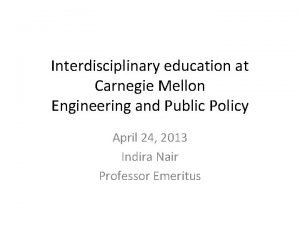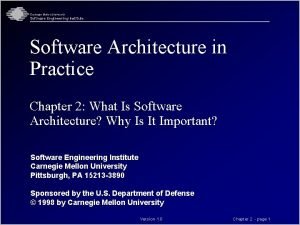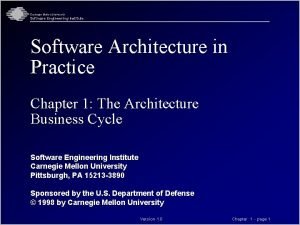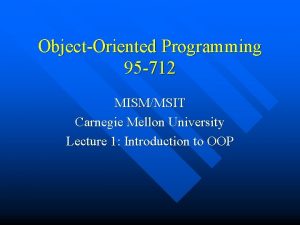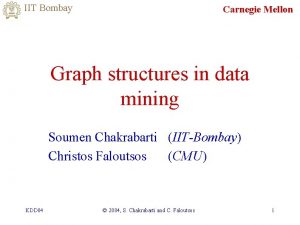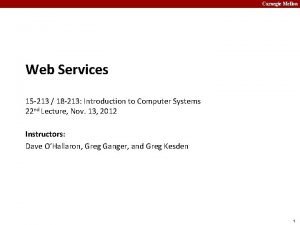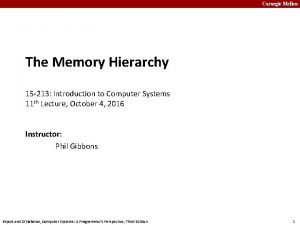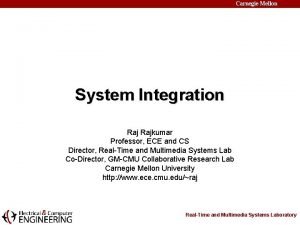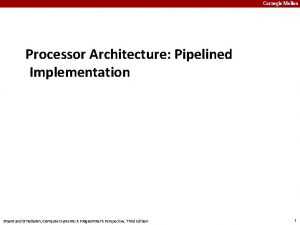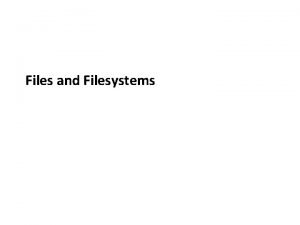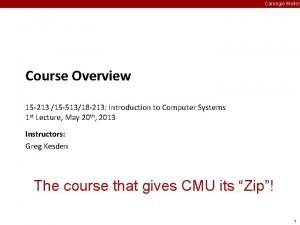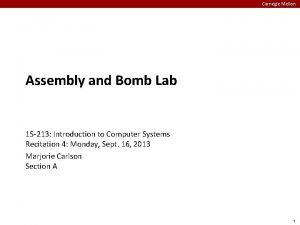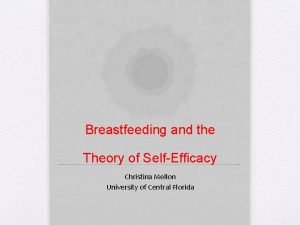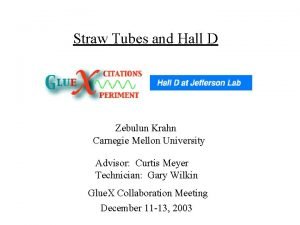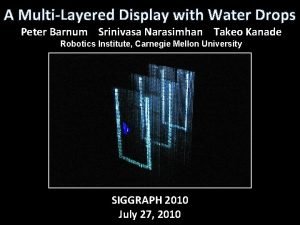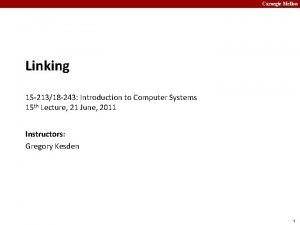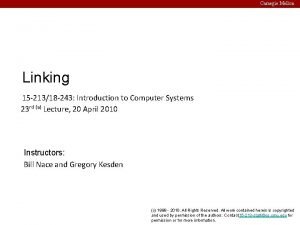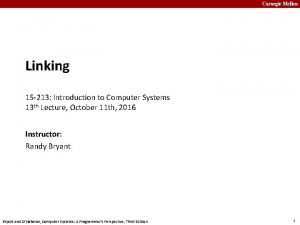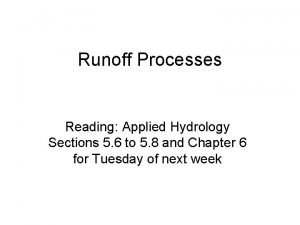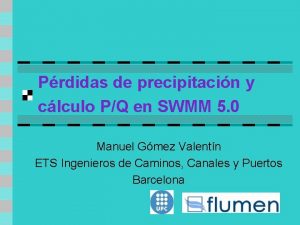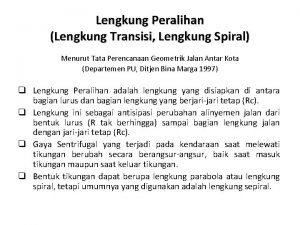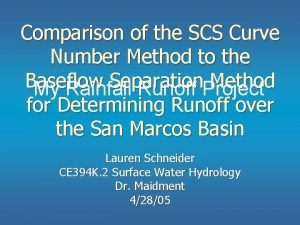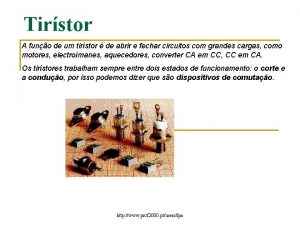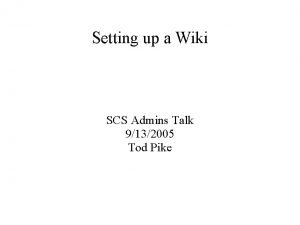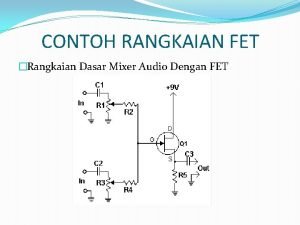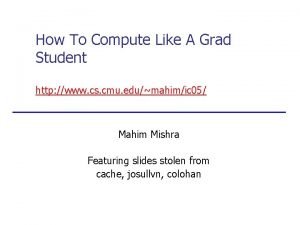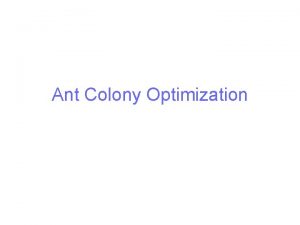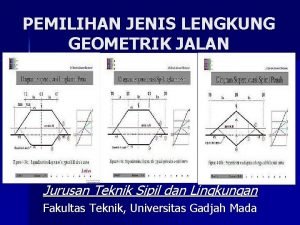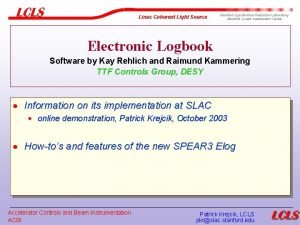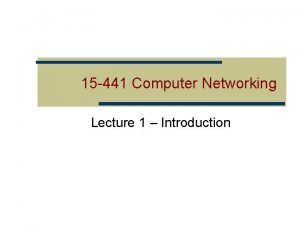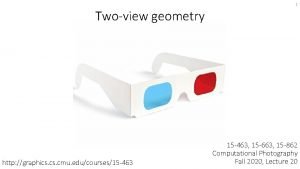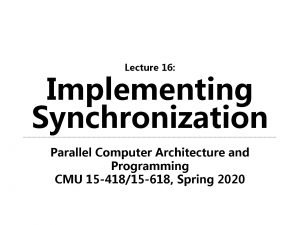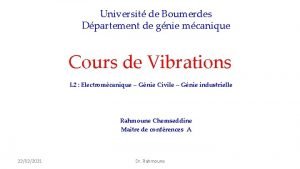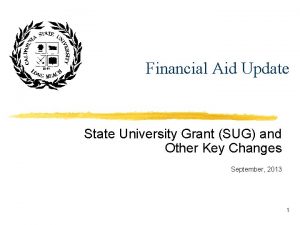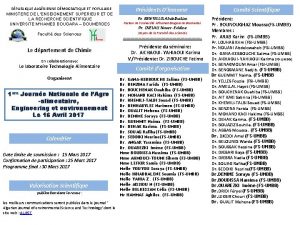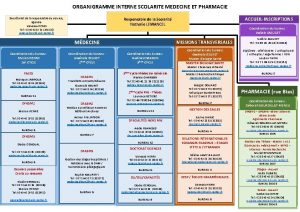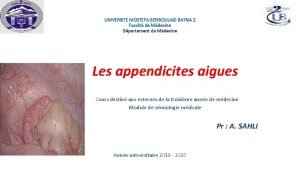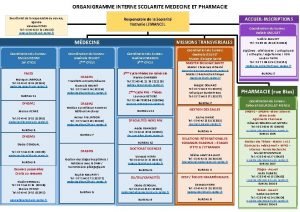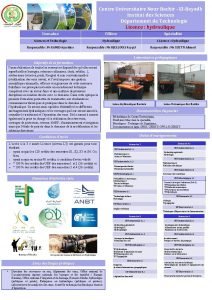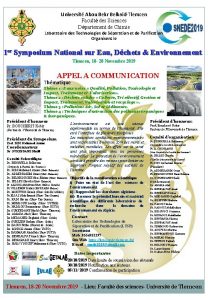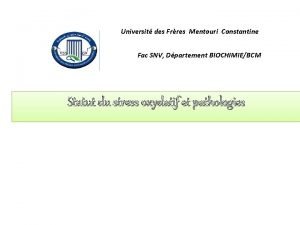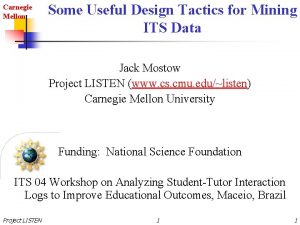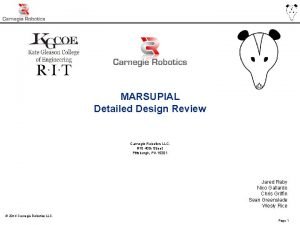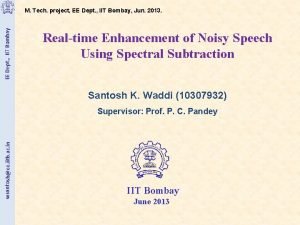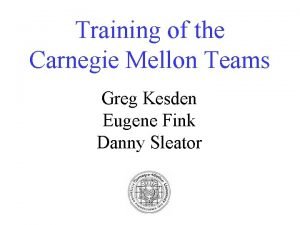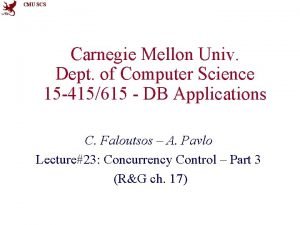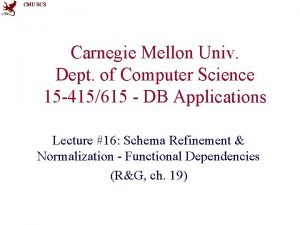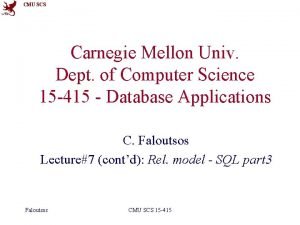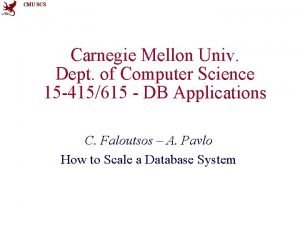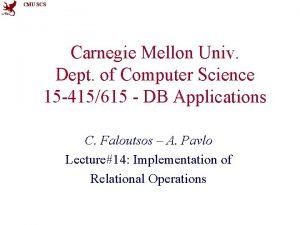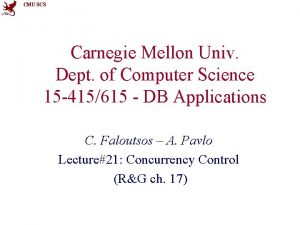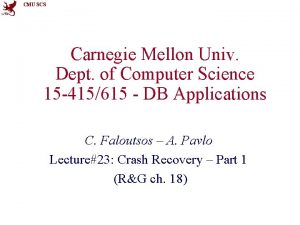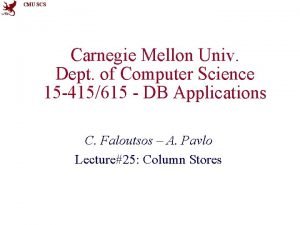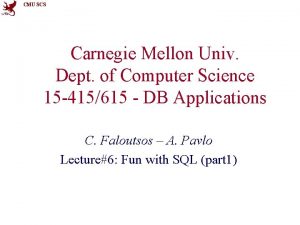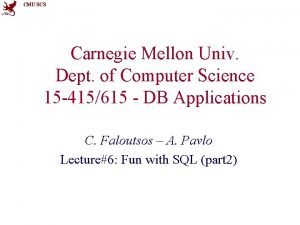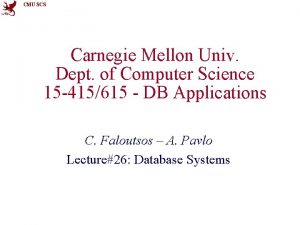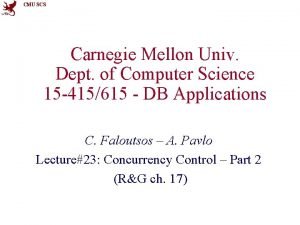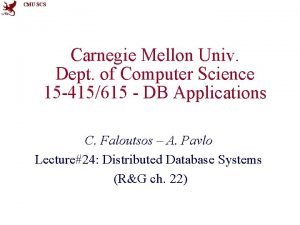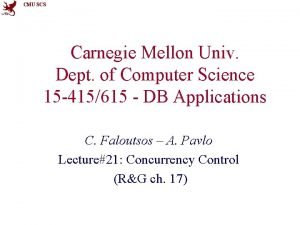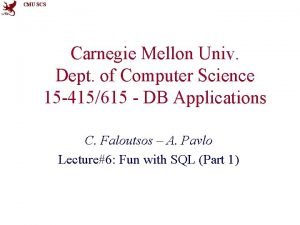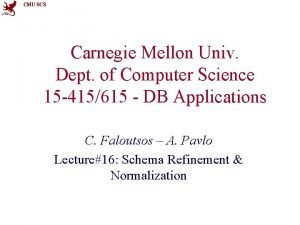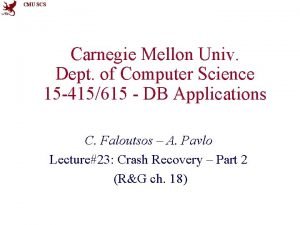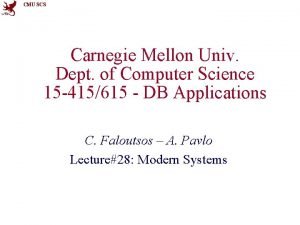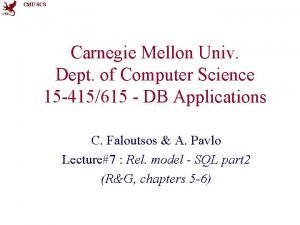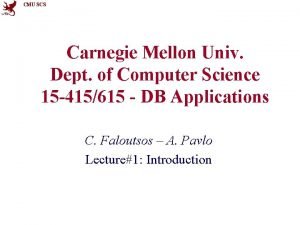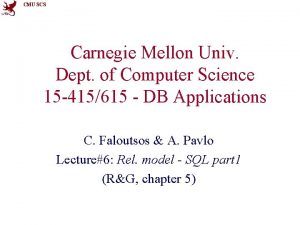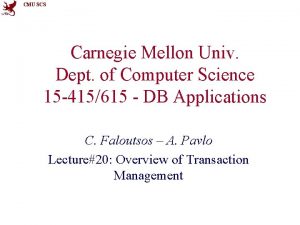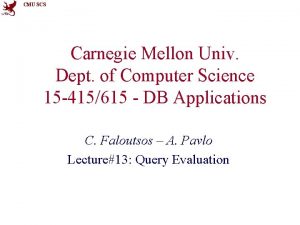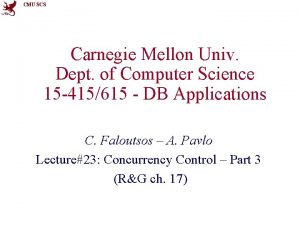CMU SCS Carnegie Mellon Univ Dept of Computer
































































































































- Slides: 128

CMU SCS Carnegie Mellon Univ. Dept. of Computer Science 15 -415 - Database Applications Lecture#9: Indexing (R&G ch. 10) Faloutsos CMU SCS 15 -415

CMU SCS Outline • • • Motivation ISAM B-trees (not in book) B+ trees duplicates B+ trees in practice Faloutsos CMU SCS 15 -415 2

CMU SCS Introduction • How to support range searches? • equality searches? Faloutsos CMU SCS 15 -415 3

CMU SCS Range Searches • ``Find all students with gpa > 3. 0’’ • may be slow, even on sorted file • What to do? Page 1 Faloutsos Page 2 Page 3 CMU SCS 15 -415 Page N Data File 4

CMU SCS Range Searches • ``Find all students with gpa > 3. 0’’ • may be slow, even on sorted file • Solution: Create an `index’ file. Page 1 Faloutsos Page 2 Index File k. N k 1 k 2 Page 3 CMU SCS 15 -415 Page N Data File 5

CMU SCS Range Searches • More details: • if index file is small, do binary search there • Otherwise? ? Page 1 Faloutsos Page 2 Index File k. N k 1 k 2 Page 3 CMU SCS 15 -415 Page N Data File 6

CMU SCS ISAM • Repeat recursively! Non-leaf Pages Leaf Pages Faloutsos CMU SCS 15 -415 7

CMU SCS ISAM • OK - what if there are insertions and overflows? Non-leaf Pages Leaf Pages Faloutsos CMU SCS 15 -415 8

CMU SCS ISAM • Overflow pages, linked to the primary page Non-leaf Pages Leaf Pages Overflow page Faloutsos Primary pages CMU SCS 15 -415 9

CMU SCS Example ISAM Tree • 2 entries per page Root 40 10* 15* Faloutsos 20 33 20* 27* 51 33* 37* 40* CMU SCS 15 -415 46* 51* 63 55* 63* 97* 10

CMU SCS ISAM Details • format of an index page? • how full would a newly created ISAM be? Faloutsos CMU SCS 15 -415 11

CMU SCS ISAM Details • format of an index page? • how full would a newly created ISAM be? – ~80 -90% (not 100%) P 0 Faloutsos K 1 P 1 K 2 P 2 CMU SCS 15 -415 K m Pm 12

CMU SCS ISAM is a STATIC Structure • that is, index pages don’t change • File creation: Leaf (data) pages allocated sequentially, sorted by search key; then index pages allocated, then overflow pgs. Faloutsos CMU SCS 15 -415 13

CMU SCS ISAM is a STATIC Structure • Search: Start at root; use key comparisons to go to leaf. • Cost = log F N ; • F = # entries/pg (i. e. , fanout), • N = # leaf pgs Faloutsos CMU SCS 15 -415 14

CMU SCS ISAM is a STATIC Structure Insert: Find leaf that data entry belongs to, and put it there. Overflow page if necessary. Delete: Find and remove from leaf; if empty page, de-allocate. Faloutsos CMU SCS 15 -415 15

CMU SCS Example: Insert 23*, 48*, 41*, 42* Root 40 Index Pages 20 33 20* 27* 51 63 51* 55* Primary Leaf 10* 15* 33* 37* 40* 46* 48* 41* Pages Overflow 23* 63* 97* Pages 42* Faloutsos CMU SCS 15 -415 16

CMU SCS . . . then delete 42*, 51*, 97* Root 40 Index Pages 20 33 20* 27* 51 63 51* 55* Primary Leaf 10* 15* 33* 37* 40* 46* 48* 41* Pages Overflow 23* 63* 97* Pages 42* * Note that 51* appears in index levels, but not in leaf! Faloutsos CMU SCS 15 -415 17

CMU SCS ISAM ---- Issues? • Pros – ? ? • Cons – ? ? Faloutsos CMU SCS 15 -415 18

CMU SCS Outline • • • Motivation ISAM B-trees (not in book) B+ trees duplicates B+ trees in practice Faloutsos CMU SCS 15 -415 19

CMU SCS B-trees • the most successful family of index schemes (B-trees, B+-trees, B*-trees) • Can be used for primary/secondary, clustering/non-clustering index. • balanced “n-way” search trees Faloutsos CMU SCS 15 -415 20

CMU SCS B-trees [Rudolf Bayer and Mc. Creight, E. M. Organization and Maintenance of Large Ordered Indexes. Acta Informatica 1, 173189, 1972. ] Faloutsos CMU SCS 15 -415 21

CMU SCS B-trees Eg. , B-tree of order d=1: 6 <6 >6 1 Faloutsos 3 9 <9 7 >9 13 CMU SCS 15 -415 22

CMU SCS B - tree properties: • each node, in a B-tree of order d: – – – Key order at most n=2 d keys at least d keys (except root, which may have just 1 key) all leaves at the same level if number of pointers is k, then node has exactly k-1 keys – (leaves are empty) pn p 1 v 2 … vn-1 Faloutsos CMU SCS 15 -415 23

CMU SCS Properties • “block aware” nodes: each node -> disk page • O(log (N)) for everything! (ins/del/search) • typically, if d = 50 - 100, then 2 - 3 levels • utilization >= 50%, guaranteed; on average 69% Faloutsos CMU SCS 15 -415 24

CMU SCS Queries • Algo for exact match query? (eg. , ssn=8? ) 6 <6 >6 1 Faloutsos 3 9 <9 >9 7 13 CMU SCS 15 -415 25

CMU SCS JAVA animation! http: //slady. net/java/bt/ strongly recommended! Faloutsos CMU SCS 15 -415 26

CMU SCS Queries • Algo for exact match query? (eg. , ssn=8? ) 6 <6 >6 1 Faloutsos 3 9 <9 >9 7 13 CMU SCS 15 -415 27

CMU SCS Queries • Algo for exact match query? (eg. , ssn=8? ) 6 <6 >6 1 Faloutsos 3 9 <9 >9 7 13 CMU SCS 15 -415 28

CMU SCS Queries • Algo for exact match query? (eg. , ssn=8? ) 6 <6 >6 1 Faloutsos 3 9 <9 >9 7 13 CMU SCS 15 -415 29

CMU SCS Queries • Algo for exact match query? (eg. , ssn=8? ) 6 <6 >6 1 Faloutsos 3 9 <9 H steps (= disk accesses) >9 7 13 CMU SCS 15 -415 30

CMU SCS Queries • what about range queries? (eg. , 5<salary<8) • Proximity/ nearest neighbor searches? (eg. , salary ~ 8 ) Faloutsos CMU SCS 15 -415 31

CMU SCS Queries • what about range queries? (eg. , 5<salary<8) • Proximity/ nearest neighbor searches? (eg. , salary ~ 8 ) 6 <6 >6 1 Faloutsos 3 9 <9 7 CMU SCS 15 -415 >9 13 32

CMU SCS Queries • what about range queries? (eg. , 5<salary<8) • Proximity/ nearest neighbor searches? (eg. , salary ~ 8 ) 6 <6 >6 1 Faloutsos 3 9 <9 7 CMU SCS 15 -415 >9 13 33

CMU SCS Queries • what about range queries? (eg. , 5<salary<8) • Proximity/ nearest neighbor searches? (eg. , salary ~ 8 ) 6 <6 >6 1 Faloutsos 3 9 <9 7 CMU SCS 15 -415 >9 13 34

CMU SCS Queries • what about range queries? (eg. , 5<salary<8) • Proximity/ nearest neighbor searches? (eg. , salary ~ 8 ) 6 <6 >6 1 Faloutsos 3 9 <9 7 CMU SCS 15 -415 >9 13 35

CMU SCS B-trees: Insertion • Insert in leaf; on overflow, push middle up (recursively) • split: preserves B - tree properties Faloutsos CMU SCS 15 -415 36

CMU SCS B-trees Easy case: Tree T 0; insert ‘ 8’ 6 <6 >6 1 Faloutsos 3 9 <9 7 >9 13 CMU SCS 15 -415 37

CMU SCS B-trees Tree T 0; insert ‘ 8’ 6 <6 >6 1 Faloutsos 3 9 >9 <9 7 8 CMU SCS 15 -415 13 38

CMU SCS B-trees Hardest case: Tree T 0; insert ‘ 2’ 6 <6 >6 1 3 9 <9 7 >9 13 2 Faloutsos CMU SCS 15 -415 39

CMU SCS B-trees Hardest case: Tree T 0; insert ‘ 2’ 6 1 2 3 9 7 13 push middle up Faloutsos CMU SCS 15 -415 40

CMU SCS B-trees Hardest case: Tree T 0; insert ‘ 2’ Ovf; push middle 1 Faloutsos 22 6 7 3 CMU SCS 15 -415 9 13 41

CMU SCS B-trees Hardest case: Tree T 0; insert ‘ 2’ 6 Final state 9 2 1 Faloutsos 7 3 CMU SCS 15 -415 13 42

CMU SCS B-trees: Insertion • Insert in leaf; on overflow, push middle up (recursively – ‘propagate split’) • split: preserves all B - tree properties (!!) • notice how it grows: height increases when root overflows & splits • Automatic, incremental re-organization (contrast with ISAM!) Faloutsos CMU SCS 15 -415 43

CMU SCS Pseudo-code INSERTION OF KEY ’K’ find the correct leaf node ’L’; if ( ’L’ overflows ){ split ’L’, and push middle key to parent node ’P’; if (’P’ overflows){ repeat the split recursively; } else{ add the key ’K’ in node ’L’; /* maintaining the key order in ’L’ */ } Faloutsos CMU SCS 15 -415 44

CMU SCS Overview • . . . • B – trees – Dfn, Search, insertion, deletion • . . . Faloutsos CMU SCS 15 -415 45

CMU SCS Deletion Rough outline of algo: • Delete key; • on underflow, may need to merge In practice, some implementors just allow underflows to happen… Faloutsos CMU SCS 15 -415 46

CMU SCS B-trees – Deletion Easiest case: Tree T 0; delete ‘ 3’ 6 <6 >6 1 Faloutsos 3 9 <9 7 >9 13 CMU SCS 15 -415 47

CMU SCS B-trees – Deletion Easiest case: Tree T 0; delete ‘ 3’ 6 <6 >6 1 Faloutsos 9 <9 7 >9 13 CMU SCS 15 -415 48

CMU SCS B-trees – Deletion • Case 1: delete a key at a leaf – no underflow • Case 2: delete non-leaf key – no underflow • Case 3: delete leaf-key; underflow, and ‘rich sibling’ • Case 4: delete leaf-key; underflow, and ‘poor sibling’ Faloutsos CMU SCS 15 -415 49

CMU SCS B-trees – Deletion • Case 1: delete a key at a leaf – no underflow (delete 3 from T 0) 6 <6 >6 1 Faloutsos 3 9 <9 7 CMU SCS 15 -415 >9 13 50

CMU SCS B-trees – Deletion • Case 2: delete a key at a non-leaf – no underflow (eg. , delete 6 from T 0) 6 <6 >6 1 Faloutsos 3 Delete & promote, ie: 9 <9 7 CMU SCS 15 -415 >9 13 51

CMU SCS B-trees – Deletion • Case 2: delete a key at a non-leaf – no underflow (eg. , delete 6 from T 0) 9 <6 >6 1 Faloutsos 3 Delete & promote, ie: <9 7 CMU SCS 15 -415 >9 13 52

CMU SCS B-trees – Deletion • Case 2: delete a key at a non-leaf – no underflow (eg. , delete 6 from T 0) 3 <6 >6 1 Faloutsos Delete & promote, ie: 9 <9 7 CMU SCS 15 -415 >9 13 53

CMU SCS B-trees – Deletion • Case 2: delete a key at a non-leaf – no underflow (eg. , delete 6 from T 0) FINAL TREE <3 3 >3 1 Faloutsos 9 <9 7 CMU SCS 15 -415 >9 13 54

CMU SCS B-trees – Deletion • Case 2: delete a key at a non-leaf – no underflow (eg. , delete 6 from T 0) • Q: How to promote? • A: pick the largest key from the left sub-tree (or the smallest from the right sub-tree) • Observation: every deletion eventually becomes a deletion of a leaf key Faloutsos CMU SCS 15 -415 55

CMU SCS B-trees – Deletion • Case 1: delete a key at a leaf – no underflow • Case 2: delete non-leaf key – no underflow • Case 3: delete leaf-key; underflow, and ‘rich sibling’ • Case 4: delete leaf-key; underflow, and ‘poor sibling’ Faloutsos CMU SCS 15 -415 56

CMU SCS B-trees – Deletion • Case 3: underflow & ‘rich sibling’ (eg. , delete 7 from T 0) 6 <6 >6 1 Faloutsos 3 Delete & borrow, ie: 9 <9 7 CMU SCS 15 -415 >9 13 57

CMU SCS B-trees – Deletion • Case 3: underflow & ‘rich sibling’ (eg. , delete 7 from T 0) Rich sibling 1 Faloutsos 6 <6 >6 Delete & borrow, ie: 9 <9 3 >9 13 CMU SCS 15 -415 58

CMU SCS B-trees – Deletion • Case 3: underflow & ‘rich sibling’ • ‘rich’ = can give a key, without underflowing • ‘borrowing’ a key: THROUGH the PARENT! Faloutsos CMU SCS 15 -415 59

CMU SCS B-trees – Deletion • Case 3: underflow & ‘rich sibling’ (eg. , delete 7 from T 0) Rich sibling 1 6 <6 >6 Delete & borrow, ie: 9 <9 3 >9 13 NO!! Faloutsos CMU SCS 15 -415 60

CMU SCS B-trees – Deletion • Case 3: underflow & ‘rich sibling’ (eg. , delete 7 from T 0) 6 <6 >6 1 Faloutsos Delete & borrow, ie: 9 <9 3 >9 13 CMU SCS 15 -415 61

CMU SCS B-trees – Deletion • Case 3: underflow & ‘rich sibling’ (eg. , delete 7 from T 0) 3 <6 >6 1 Faloutsos Delete & borrow, ie: 9 <9 6 CMU SCS 15 -415 >9 13 62

CMU SCS B-trees – Deletion • Case 3: underflow & ‘rich sibling’ (eg. , delete 7 from T 0) FINAL TREE 3 <3 >3 1 Faloutsos Delete & borrow, through the parent 9 <9 6 CMU SCS 15 -415 >9 13 63

CMU SCS B-trees – Deletion • Case 1: delete a key at a leaf – no underflow • Case 2: delete non-leaf key – no underflow • Case 3: delete leaf-key; underflow, and ‘rich sibling’ • Case 4: delete leaf-key; underflow, and ‘poor sibling’ Faloutsos CMU SCS 15 -415 64

CMU SCS B-trees – Deletion • Case 4: underflow & ‘poor sibling’ (eg. , delete 13 from T 0) 6 <6 >6 1 Faloutsos 3 9 <9 7 CMU SCS 15 -415 >9 13 65

CMU SCS B-trees – Deletion • Case 4: underflow & ‘poor sibling’ (eg. , delete 13 from T 0) 6 <6 >6 1 Faloutsos 3 9 <9 >9 7 CMU SCS 15 -415 66

CMU SCS B-trees – Deletion • Case 4: underflow & ‘poor sibling’ (eg. , delete 13 from T 0) 6 <6 >6 1 Faloutsos 3 9 <9 >9 A: merge w/ ‘poor’ sibling 7 CMU SCS 15 -415 67

CMU SCS B-trees – Deletion • Case 4: underflow & ‘poor sibling’ (eg. , delete 13 from T 0) • Merge, by pulling a key from the parent • exact reversal from insertion: ‘split and push up’, vs. ‘merge and pull down’ • Ie. : Faloutsos CMU SCS 15 -415 68

CMU SCS B-trees – Deletion • Case 4: underflow & ‘poor sibling’ (eg. , delete 13 from T 0) <6 A: merge w/ ‘poor’ sibling 6 >6 1 Faloutsos 3 7 CMU SCS 15 -415 9 69

CMU SCS B-trees – Deletion • Case 4: underflow & ‘poor sibling’ (eg. , delete 13 from T 0) FINAL TREE <6 6 >6 1 Faloutsos 3 7 CMU SCS 15 -415 9 70

CMU SCS B-trees – Deletion • • Case 4: underflow & ‘poor sibling’ -> ‘pull key from parent, and merge’ Q: What if the parent underflows? A: repeat recursively Faloutsos CMU SCS 15 -415 71

CMU SCS B-tree deletion - pseudocode DELETION OF KEY ’K’ locate key ’K’, in node ’N’ if( ’N’ is a non-leaf node) { delete ’K’ from ’N’; find the immediately largest key ’K 1’; /* which is guaranteed to be on a leaf node ’L’ */ copy ’K 1’ in the old position of ’K’; invoke this DELETION routine on ’K 1’ from the leaf node ’L’; else { /* ’N’ is a leaf node */. . . (next slide. . ) Faloutsos CMU SCS 15 -415 72

CMU SCS B-tree deletion - pseudocode /* ’N’ is a leaf node */ if( ’N’ underflows ){ let ’N 1’ be the sibling of ’N’; if( ’N 1’ is "rich"){ /* ie. , N 1 can lend us a key */ borrow a key from ’N 1’ THROUGH the parent node; }else{ /* N 1 is 1 key away from underflowing */ MERGE: pull the key from the parent ’P’, and merge it with the keys of ’N’ and ’N 1’ into a new node; if( ’P’ underflows){ repeat recursively } } } Faloutsos CMU SCS 15 -415 73

CMU SCS Outline • Motivation • ISAM • B-trees (not in book) – algorithms – extensions • B+ trees • duplicates • B+ trees in practice Faloutsos CMU SCS 15 -415 74

CMU SCS Variations • How could we do even better than the Btrees above? Faloutsos CMU SCS 15 -415 75

CMU SCS B*-tree • In B-trees, worst case util. = 50%, if we have just split all the pages • how to increase the utilization of B - trees? • . . with B* - trees! Faloutsos CMU SCS 15 -415 76

CMU SCS B-trees and B*-trees Eg. , Tree T 0; insert ‘ 2’ 6 <6 >6 1 3 9 <9 7 >9 13 2 Faloutsos CMU SCS 15 -415 77

CMU SCS B*-trees: deferred split! • Instead of splitting, LEND keys to sibling! (through PARENT, of course!) 6 <6 >6 1 3 9 <9 7 >9 13 2 Faloutsos CMU SCS 15 -415 78

CMU SCS B*-trees: deferred split! • Instead of splitting, LEND keys to sibling! (through PARENT, of course!) 3 <3 >3 1 2 9 >9 <9 6 FINAL TREE 7 13 2 Faloutsos CMU SCS 15 -415 79

CMU SCS B*-trees: deferred split! • Notice: shorter, more packed, faster tree • It’s a rare case, where space utilization and speed improve together • BUT: What if the sibling has no room for our ‘lending’? Faloutsos CMU SCS 15 -415 80

CMU SCS B*-trees: deferred split! • A: 2 -to-3 split: get the keys from the sibling, pool them with ours (and a key from the parent), and split in 3. • Could we extend the idea to 3 -to-4 split, 4 to-5 etc? Faloutsos CMU SCS 15 -415 81

CMU SCS B*-trees: deferred split! • A: 2 -to-3 split: get the keys from the sibling, pool them with ours (and a key from the parent), and split in 3. • Could we extend the idea to 3 -to-4 split, 4 to-5 etc? • Yes, but: diminishing returns Faloutsos CMU SCS 15 -415 82

CMU SCS Outline • • • Motivation ISAM B-trees (not in book) B+ trees duplicates B+ trees in practice Faloutsos CMU SCS 15 -415 83

CMU SCS B+ trees - Motivation B-tree – print keys in sorted order: 6 <6 >6 1 Faloutsos 3 9 <9 7 >9 13 CMU SCS 15 -415 84

CMU SCS B+ trees - Motivation B-tree needs back-tracking – how to avoid it? 6 <6 >6 1 Faloutsos 3 9 <9 7 >9 13 CMU SCS 15 -415 85

CMU SCS B+ trees - Motivation Stronger reason: for clustering index, data records are scattered: 6 <6 >6 1 Faloutsos 3 9 <9 7 >9 13 CMU SCS 15 -415 86

CMU SCS Solution: + B - trees • facilitate sequential ops • They string all leaf nodes together • AND • replicate keys from non-leaf nodes, to make sure every key appears at the leaf level • (vital, for clustering index!) Faloutsos CMU SCS 15 -415 87

CMU SCS B+ trees 6 <6 >=6 1 Faloutsos 3 9 >=9 <9 6 7 CMU SCS 15 -415 9 13 88

CMU SCS B+ trees 6 <6 >=6 1 Faloutsos 3 9 >=9 <9 6 7 CMU SCS 15 -415 9 13 89

CMU SCS B+trees • More details: next (and textbook) • In short: on split – at leaf level: COPY middle key upstairs – at non-leaf level: push middle key upstairs (as in plain B-tree) Faloutsos CMU SCS 15 -415 90

CMU SCS Example B+ Tree • Search begins at root, and key comparisons direct it to a leaf (as in ISAM). • Search for 5*, 15*, all data entries >= 24*. . . Root 13 2* 3* 5* 7* 14* 16* 17 24 30 19* 20* 22* 24* 27* 29* 33* 34* 38* 39* Based on the search for 15*, we know it is not in the tree! Faloutsos CMU SCS 15 -415 91

CMU SCS B+ Trees in Practice • Typical order: 100. Typical fill-factor: 67%. – average fanout = 2*100*0. 67 = 134 • Typical capacities: – Height 4: 1334 = 312, 900, 721 entries – Height 3: 1333 = 2, 406, 104 entries Faloutsos CMU SCS 15 -415 92

CMU SCS B+ Trees in Practice • Can often keep top levels in buffer pool: – Level 1 = 1 page = 8 KB – Level 2 = 134 pages = 1 MB – Level 3 = 17, 956 pages = 140 MB Faloutsos CMU SCS 15 -415 93

CMU SCS Inserting a Data Entry into a B+ Tree • Find correct leaf L. • Put data entry onto L. – If L has enough space, done! – Else, must split L (into L and a new node L 2) • Redistribute entries evenly, copy up middle key. • parent node may overflow – but then: push up middle key. Splits “grow” tree; root split increases height. Faloutsos CMU SCS 15 -415 94

CMU SCS Example B+ Tree - Inserting 8* Root 13 2* 3* 5* Faloutsos 7* 14* 16* 17 24 19* 20* 22* 23* CMU SCS 15 -415 24* 27* 29* 95

CMU SCS Example B+ Tree - Inserting 8* Root 13 2* 3* 5* 7* Faloutsos 13 17 24* 27* 29* 24 >=5 <5 3* 24 19* 20* 22* 23* 14* 16* 5* 2* 17 5* 7* 8* 14* 16* CMU SCS 15 -415 19* 20* 22* 23* 24* 27* 29* 96

CMU SCS Example B+ Tree - Inserting 21* Root 5 13 17 24 2* 3* 5* 7* 8* 14* 16* 19* 20* 22* 23* Faloutsos CMU SCS 15 -415 24* 27* 29* 97

CMU SCS Example B+ Tree - Inserting 21* Root 5 13 17 24 2* 3* 5* 7* 8* 14* 16* 19* 20* 22* 23* 2* 3* 5* 7* 8* 14* 16* 19* 20* Faloutsos CMU SCS 15 -415 24* 27* 29* 21* 22* 23* 24* 27* 29* 98

CMU SCS Example B+ Tree Root 17 5 2* 3* 21 13 5* 7* 8* 14* 16* 19* 20* 24 21* 22* 23* 24* 27* 29* • Notice that root was split, increasing height. • Could use defer-split here. (Pros/Cons? ) Faloutsos CMU SCS 15 -415 99

CMU SCS Example: Data vs. Index Page Split Data Page Split • leaf: ‘copy’ • non-leaf: ‘push’ 2* • why not ‘copy’ @ non-leaves? Index Page Split 5 Faloutsos 3* 13 2* 7* 5* 7* 8* … 5 5* 3* 8* 5 13 17 21 24 17 21 CMU SCS 15 -415 24 100

CMU SCS Now you try… Root 30 5 2* 3* 13 5* … (not shown) 20 7* 8* 11* 14* 16* 21* 22* 23* Insert the following data entries (in order): 28*, 6*, 25* Faloutsos CMU SCS 15 -415 101

CMU SCS Answer… After inserting 28*, 6* 30 5 2* 3* 7 5* 6* 13 … 20 7* 8* 11* 14* 16* 21* 22* 23* 28* After inserting 25* Faloutsos CMU SCS 15 -415 102

CMU SCS Answer… After inserting 25* 13 5 2* 3* Faloutsos 30 20 7 5* 6* 7* 8* 11* 14* 16* CMU SCS 15 -415 … 23 21* 22* 23* 25* 28* 103

CMU SCS Deleting a Data Entry from a B+ Tree • Start at root, find leaf L where entry belongs. • Remove the entry. – If L is at least half-full, done! – If L underflows • Try to re-distribute, borrowing from sibling (adjacent node with same parent as L). • If re-distribution fails, merge L and sibling. – update parent – and possibly merge, recursively Faloutsos CMU SCS 15 -415 104

CMU SCS Example: Delete 19* & 20* Root 17 12 5 2* 3* 13 5* 7* 8* Deleting 19* is easy: 14* 16* Root 24 19* 22* 20* 22* 30 24* 27* 29* 33* 34* 38* 39* 17 3 5 2* 3* 27 13 5* 7* 8* 14* 16* 22* 24* 30 27* 29* • Deleting 20* -> re-distribution (notice: Faloutsos 27 copied up) CMU SCS 15 -415 33* 34* 38* 39* 105

CMU SCS . . . And Then Deleting 24* Root 3 5 2* 3* 27 13 5* 7* 8* 14* 16* Root 4 5 2* 3* 17 22* 24* 7* 8* 27* 29* 30 14* 16* 22* 27* 29* SCS 15 -415 • Must merge leaves. CMU… but are we done? ? Faloutsos 33* 34* 38* 39* 17 13 5* 30 33* 34* 38* 39* 106

CMU SCS . . . Merge Non-Leaf Nodes, Shrink Tree Root 4 5 2* 3* 30 13 5* 7* 8* 22* 27* 29* 14* 16* 33* 34* 38* 39* Root 5 2* 17 5 3* Faloutsos 5* 7* 8* 13 17 30 14* 16* CMU SCS 15 -415 22* 27* 29* 33* 34* 38* 39* 107

CMU SCS Example of Non-leaf Redistribution • Tree is shown below during deletion of 24*. • Now, we can re-distribute keys Root 22 5 2* 3* 5* 7* 8* Faloutsos 13 14* 16* 17 30 20 17* 18* CMU SCS 15 -415 20* 21* 22* 27* 29* 33* 34* 38* 39* 108

CMU SCS After Re-distribution • need only re-distribute ‘ 20’; did ‘ 17’, too • why would we want to re-distributed more keys? Root 17 5 2* 3* Faloutsos 5* 7* 8* 13 14* 16* 20 17* 18* CMU SCS 15 -415 20* 21* 22 30 22* 27* 29* 33* 34* 38* 39* 109

CMU SCS Main observations for deletion • If a key value appears twice (leaf + nonleaf), the above algorithms delete it from the leaf, only • why not non-leaf, too? Faloutsos CMU SCS 15 -415 110

CMU SCS Main observations for deletion • If a key value appears twice (leaf + nonleaf), the above algorithms delete it from the leaf, only • why not non-leaf, too? • ‘lazy deletions’ - in fact, some vendors just mark entries as deleted (~ underflow), – and reorganize/compact later Faloutsos CMU SCS 15 -415 111

CMU SCS Recap: main ideas • on overflow, split (and ‘push’, or ‘copy’) – or consider deferred split • on underflow, borrow keys; or merge – or let it underflow. . . Faloutsos CMU SCS 15 -415 112

CMU SCS Outline • • • Motivation ISAM B-trees (not in book) B+ trees duplicates B+ trees in practice – prefix compression; bulk-loading; ‘order’ Faloutsos CMU SCS 15 -415 113

CMU SCS B+ trees with duplicates • Everything so far: assumed unique key values • How to extend B+-trees for duplicates? – Alt. 2: <key, rid> – Alt. 3: <key, {rid list}> • 2 approaches, roughly equivalent Faloutsos CMU SCS 15 -415 114

CMU SCS B+ trees with duplicates • approach#1: repeat the key values, and extend B+ tree algo’s appropriately - eg. many ‘ 14’s 13 2* 3* 5* Faloutsos 7* 13* 14* 14 24 14* 22* 23* CMU SCS 15 -415 24* 27* 29* 115

CMU SCS B+ trees with duplicates • approach#1: subtle problem with deletion: • treat rid as part of the key, thus making it unique 13 2* 3* 5* Faloutsos 7* 13* 14* 14 24 14* 22* 23* CMU SCS 15 -415 24* 27* 29* 116

CMU SCS B+ trees with duplicates • approach#2: store each key value: once • but store the {rid list} as variable-length field (and use overflow pages, if needed) 13 2* 3* 5* Faloutsos 7* 13* 14* {rid list} {rid list, cont’d} 14 24 22* 23* CMU SCS 15 -415 24* 27* 29* 117

CMU SCS Outline • • • Motivation ISAM B-trees (not in book) B+ trees duplicates B+ trees in practice – prefix compression; bulk-loading; ‘order’ Faloutsos CMU SCS 15 -415 118

CMU SCS Prefix Key Compression • Important to increase fan-out. (Why? ) • Key values in index entries only `direct traffic’; can often compress them. Papadopoulos Faloutsos Pernikovskaya CMU SCS 15 -415 119

CMU SCS Prefix Key Compression • Important to increase fan-out. (Why? ) • Key values in index entries only `direct traffic’; can often compress them. Pap Faloutsos Per <room for more separators/keys> CMU SCS 15 -415 120

CMU SCS Bulk Loading of a B+ Tree • In an empty tree, insert many keys • Why not one-at-a-time? Faloutsos CMU SCS 15 -415 121

CMU SCS Bulk Loading of a B+ Tree • Initialization: Sort all data entries • scan list; whenever enough for a page, pack • <repeat for upper level - even faster than book’s algo> Root 3* 4* Faloutsos Sorted pages of data entries; not yet in B+ tree 6* 9* 10* 11* 12* 13* 20* 22* 23* 31* 35* 36* CMU SCS 15 -415 38* 41* 44* 122

CMU SCS Bulk Loading (Contd. ) Root • Book’s algo • (any problems? ) 10 12 6 3* 4* 6* 9* 20 23 20 10 Faloutsos 3* 4* 12 CMU SCS 15 -415 6* 9* not yet in B+ tree 10* 11* 12* 13* 20*22* 23* 31* 35* 36* 38*41* 44* Root 6 Data entry pages 35 Data entry pages not yet in B+ tree 35 23 38 123 10* 11* 12* 13* 20*22* 23* 31* 35* 36* 38*41* 44*

CMU SCS Outline • • • Motivation ISAM B-trees (not in book) B+ trees duplicates B+ trees in practice – prefix compression; bulk-loading; ‘order’ Faloutsos CMU SCS 15 -415 124

CMU SCS A Note on `Order’ • Order (d) concept replaced by physical space criterion in practice (`at least half-full’). • Why do we need it? – Index pages can typically hold many more entries than leaf pages. – Variable sized records and search keys mean different nodes will contain different numbers of entries. – Even with fixed length fields, multiple records with the same search key value (duplicates) can lead to variable-sized data entries (if we use Alternative (3)). Faloutsos CMU SCS 15 -415 125

CMU SCS A Note on `Order’ • Many real systems are even sloppier than this: they allow underflow, and only reclaim space when a page is completely empty. • (what are the benefits of such ‘slopiness’? ) Faloutsos CMU SCS 15 -415 126

CMU SCS Conclusions • B+tree is the prevailing indexing method • Excellent, O(log. N) worst-case performance for ins/del/search; (~3 -4 disk accesses in practice) • guaranteed 50% space utilization; avg 69% Faloutsos CMU SCS 15 -415 127

CMU SCS Conclusions • Can be used for any type of index: primary/secondary, sparse (clustering), or dense (non-clustering) • Several fine-extensions on the basic algorithm – deferred split; prefix compression; (underflows) – bulk-loading – duplicate handling Faloutsos CMU SCS 15 -415 128
 Cmu comp bio
Cmu comp bio Carnegie mellon interdisciplinary
Carnegie mellon interdisciplinary Carnegie mellon software architecture
Carnegie mellon software architecture Cmu bomb threat
Cmu bomb threat Carnegie mellon software architecture
Carnegie mellon software architecture Citi training cmu
Citi training cmu Mism carnegie mellon
Mism carnegie mellon Randy pausch carnegie mellon
Randy pausch carnegie mellon National robotics initiative
National robotics initiative Iit
Iit 18-213 cmu
18-213 cmu Cmu vpn
Cmu vpn Carnegie mellon
Carnegie mellon Carnegie mellon
Carnegie mellon Carnegie mellon
Carnegie mellon Carnegie mellon
Carnegie mellon Carnegie mellon fat letter
Carnegie mellon fat letter 15-513 cmu
15-513 cmu Cmu bomb lab
Cmu bomb lab Mellon serbia iskustva
Mellon serbia iskustva Carneigh mellon
Carneigh mellon Conclusion of breastfeeding
Conclusion of breastfeeding Bny mellon health savings account
Bny mellon health savings account Mellon tubes
Mellon tubes Water mellon
Water mellon Mellon elf
Mellon elf Mellon elf
Mellon elf Mellon elf
Mellon elf Scs desco
Scs desco Scs method
Scs method Lluvia neta
Lluvia neta Tabel panjang lengkung peralihan
Tabel panjang lengkung peralihan Antecedent moisture condition
Antecedent moisture condition Simbol komponen diac
Simbol komponen diac Scs curve number
Scs curve number Curva tiristor
Curva tiristor Wiki.scs
Wiki.scs Scs.ryerson.ca harley
Scs.ryerson.ca harley Rangkaian fet
Rangkaian fet Scs reasonable person principle
Scs reasonable person principle Scs thyristor
Scs thyristor Scs carleton
Scs carleton Scs archiver
Scs archiver Jenis lengkung
Jenis lengkung Scs elogs
Scs elogs Scs lulu
Scs lulu Scs methode
Scs methode Doc scs
Doc scs Carotenoid score
Carotenoid score 15-441
15-441 Homorogeneous
Homorogeneous Synchronization in computer architecture
Synchronization in computer architecture Ut arlington va office
Ut arlington va office Univ 3.constantine medecine
Univ 3.constantine medecine Ch rahmoune
Ch rahmoune Sug grant
Sug grant Fs boumerdes
Fs boumerdes Celcat univ nantes
Celcat univ nantes Fs.univ.umbb
Fs.univ.umbb Univ constantine 3
Univ constantine 3 Pharmacie.univ-batna2
Pharmacie.univ-batna2 Celcat univ nantes
Celcat univ nantes Univ el bayadh
Univ el bayadh Prodoc univ nantes
Prodoc univ nantes Univ prof titel
Univ prof titel Moodle univtln
Moodle univtln Mail univ ouargla
Mail univ ouargla Sfa univ poitiers
Sfa univ poitiers (univ. caxias do sul) escolha a alternativa que completa
(univ. caxias do sul) escolha a alternativa que completa Lon capa ohio univ
Lon capa ohio univ Iut valenciennes ent
Iut valenciennes ent Ent université tours
Ent université tours Snv constantine
Snv constantine Kalkulatorische zinsen
Kalkulatorische zinsen Was andrew carnegie a hero
Was andrew carnegie a hero The rise
The rise Was andrew carnegie bad
Was andrew carnegie bad Modelo carnegie
Modelo carnegie Dept nmr spectroscopy
Dept nmr spectroscopy Fl dept of agriculture
Fl dept of agriculture Finance dept structure
Finance dept structure Worcester ma building department
Worcester ma building department Andrew carnegie vertical integration
Andrew carnegie vertical integration Andrew carnegie vertical integration
Andrew carnegie vertical integration Dept. name of organization
Dept. name of organization Philanthropy carnegie
Philanthropy carnegie Mn dept of education
Mn dept of education Liz welch mississippi
Liz welch mississippi Carnegie vertical integration
Carnegie vertical integration Dept. name of organization (of affiliation)
Dept. name of organization (of affiliation) Andrew carnegie and john d. rockefeller venn diagram
Andrew carnegie and john d. rockefeller venn diagram Dale carnegie conversation stack
Dale carnegie conversation stack Ohio dept of dd
Ohio dept of dd Affiliation poster presentation
Affiliation poster presentation Carnegie learning
Carnegie learning Acadia computer science
Acadia computer science Vaginal dept
Vaginal dept Gome dept
Gome dept Gome dept
Gome dept Nyttofunktion
Nyttofunktion Gome dept
Gome dept Hoe dept
Hoe dept Firefighter oral interview questions
Firefighter oral interview questions Oviposition
Oviposition Dept of education
Dept of education Florida dept of agriculture and consumer services
Florida dept of agriculture and consumer services Florida dept of agriculture and consumer services
Florida dept of agriculture and consumer services Dept a
Dept a Central islip fire department
Central islip fire department Carnegie
Carnegie Jack carnegie
Jack carnegie Carnegie
Carnegie Bill gates founder of microsoft
Bill gates founder of microsoft Micah ennis
Micah ennis Dept of education
Dept of education Dept c13 nmr
Dept c13 nmr Pt dept logistik
Pt dept logistik Nys dept of homeland security
Nys dept of homeland security Carnegie robotics llc
Carnegie robotics llc La dept of revenue
La dept of revenue La revenue dept
La revenue dept Continuing education library oxford
Continuing education library oxford Jp morgan vertical integration
Jp morgan vertical integration Nebraska dept of agriculture
Nebraska dept of agriculture Iit
Iit Dept ind onegov
Dept ind onegov Albany county dss
Albany county dss Cmu 16-385
Cmu 16-385 Kesden cmu
Kesden cmu

